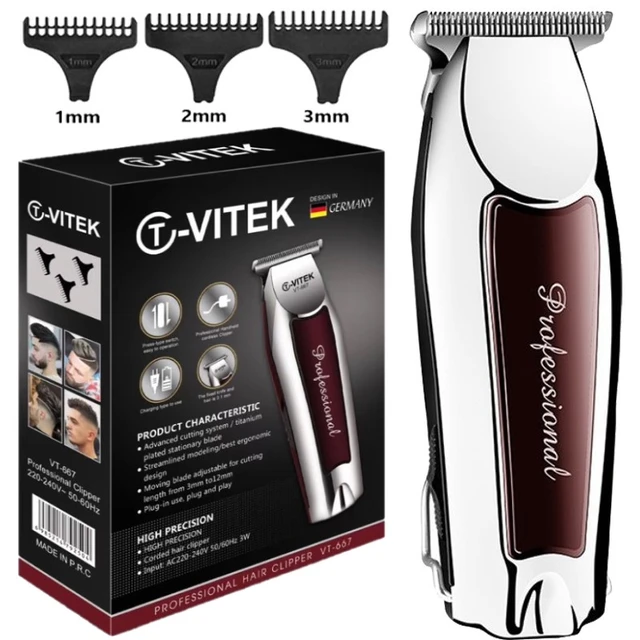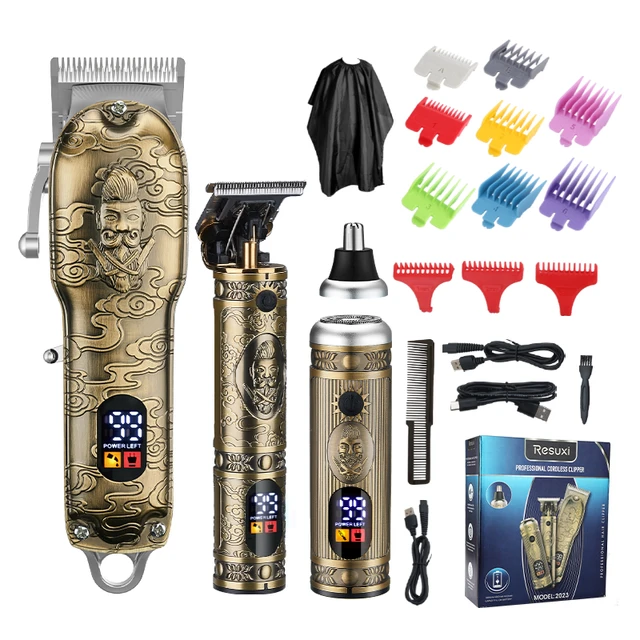Introduction:
Learning to cut men’s hair with clippers can be an empowering skill, allowing you to create tailored hairstyles and save money on salon visits. As a beginner, it’s natural to feel unsure about where to start. However, with the right approach and practice, you can gain confidence and develop the necessary techniques. In this guide, we will explore step-by-step instructions for beginners learning to cut men’s hair with clippers. From understanding the tools to practicing basic techniques, we will cover everything you need to know to begin your journey in haircutting.

How do beginners learn to cut men’s hair with a clipper?
Gather the Required Tools:
Before diving into haircutting, it’s important to gather the necessary tools. These include:
a. Clippers: Invest in a good quality pair of clippers that come with a variety of guard attachments. This allows you to achieve different hair lengths and styles.
b. Scissors: Have a pair of barber scissors or hair-cutting shears for trimming and detailing.
c. Comb: Choose a wide-toothed comb for detangling and sectioning the hair during the haircut.
d. Mirror: A handheld mirror or a wall-mounted mirror is essential for checking the sides and back of the head.
e. Towel or Cape: Use a towel or a hair-cutting cape to protect clothing from loose hair.
Familiarize Yourself with Clipper Guards and Settings:
Clipper guards determine the length of hair that will be left after a pass with the clippers. Familiarize yourself with the different guard sizes and their corresponding lengths. The numbers on the guards indicate the length in millimeters or inches. Start with larger guard sizes for longer hair, and gradually decrease the guard size for shorter lengths.
Begin with Simple Haircuts:
As a beginner, it’s recommended to start with simple haircuts and gradually progress to more complex styles. Basic haircuts like an all-around buzz cut or a simple taper can help you gain confidence and perfect your technique. Focus on achieving even lengths and clean lines before attempting more intricate styles.
Start with Dry and Clean Hair:
Ensure the hair is clean and dry before starting the haircut. Wet hair can cause the clippers to snag or pull, making the process more challenging. Washing the hair before the cut also helps remove any excess oils or product buildup, resulting in a smoother haircut.
Section the Hair:
Sectioning the hair allows for better control and ensures a more even cut. Use the comb to create vertical or horizontal sections, depending on the desired style. Clip away the sections you’re not currently working on to avoid confusion.
Start Cutting from the Sides and Back:
As a beginner, it’s often easier to start cutting from the sides and back of the head. Follow these steps:
a. Attach the Appropriate Guard: Choose a guard size that corresponds to the desired hair length. Beginners may opt for a slightly longer guard to allow room for adjustments.
b. Begin at the Sideburns: Start at the sideburns and work your way around the head, moving the clippers against the direction of hair growth. Use slow and steady movements to maintain an even length.
c. Maintain Consistency: Keep the clippers level with the scalp and make sure each pass overlaps slightly with the previous one to ensure consistent cutting.
d. Gradually Move Upwards: As you progress, gradually move upward from the sides to the back of the head, paying close attention to maintaining an even length.
e. Taper the Hairline: Use a shorter guard or no guard at all to define the hairline around the ears and the neckline. Use short and gentle upward strokes for a clean finish.
Blend the Sides and Top:
To create a seamless transition between the sides and the top, follow these steps:
a. Remove the Guard or Use a Smaller Guard: Remove the guard or switch to a smaller guard size for a shorter length.
b. Begin Blending: Start at the sides and gently blend the hair between the shorter sides and the longer top. Use short and upward strokes to create a natural and gradual transition.
c. Taper the Hair: To achieve a more gradual fade, gradually decrease the clipper’s height as you move towards the top. This creates a tapered effect.
d. Feather the Edges: Use the clippers without a guard or with a very short guard to feather the edges where the hair transitions. This helps soften any harsh lines and creates a natural and blended appearance.
Trim and Style the Top:
Once the sides and back are complete, it’s time to trim and style the hair on top. Consider the following steps:
a. Determine the Desired Length: Use scissors to trim any excess length or achieve the desired style on the top of the head. Take small, cautious snips to avoid taking off too much hair.
b. Work in Sections: Use the comb to lift sections of hair and hold them between your fingers. Trim the hair gradually, cutting across the hair shafts to create even lengths.
c. Blend with the Sides: To create a smooth transition between the top and sides, use the comb to lift the hair near the sides and blend it with the clippers, using short upward strokes.
d. Texturize and Detail: Use scissors to add texture or detail to the hair. Point-cutting or using thinning shears can help remove bulk and create texture, while careful snipping can refine the shape or add layers.
Check for Symmetry and Make Adjustments:
After completing the haircut, use a handheld mirror or a mirror reflection to check for symmetry and make any necessary adjustments. Pay attention to the hairline, side profile, and the overall balance of the haircut. Make small corrections with the clippers or scissors as needed to achieve an even and polished look.
Practice and Seek Feedback:
Remember that practice is key to improving your haircutting skills. Continue practicing on friends or family members, and seek their feedback to help identify areas for improvement. Pay attention to their preferences and adjust your technique accordingly.
Learn from Online Resources and Tutorials:
There are abundant online resources and tutorials available for learning haircutting techniques with clippers. Utilize these resources to gain further knowledge, watch demonstrations, and learn additional tips and tricks from experienced barbers and hairstylists.
Conclusion:
Learning to cut men’s hair with clippers can be an exciting and rewarding journey. As a beginner, start with simple cuts, familiarize yourself with the tools and techniques, and gradually progress to more complex styles. Remember to practice, seek feedback, and be patient with yourself as you hone your skills. With time and dedication, you will gain confidence and become proficient in giving professional-looking haircuts with clippers.




